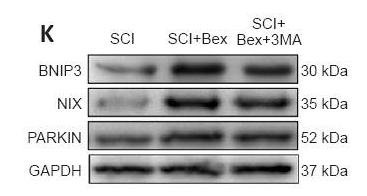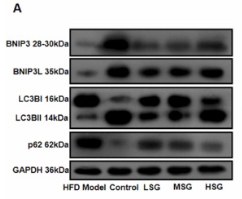BNIP3L Antibody - #DF8163
| Product: | BNIP3L Antibody |
| Catalog: | DF8163 |
| Description: | Rabbit polyclonal antibody to BNIP3L |
| Application: | WB IHC IF/ICC |
| Cited expt.: | WB |
| Reactivity: | Human, Mouse, Rat |
| Prediction: | Pig, Bovine, Horse, Sheep, Rabbit, Chicken, Xenopus |
| Mol.Wt.: | 35 kDa; 24kD(Calculated). |
| Uniprot: | O60238 |
| RRID: | AB_2841486 |
Related Downloads
Protocols
Product Info
*The optimal dilutions should be determined by the end user. For optimal experimental results, antibody reuse is not recommended.
*Tips:
WB: For western blot detection of denatured protein samples. IHC: For immunohistochemical detection of paraffin sections (IHC-p) or frozen sections (IHC-f) of tissue samples. IF/ICC: For immunofluorescence detection of cell samples. ELISA(peptide): For ELISA detection of antigenic peptide.
Cite Format: Affinity Biosciences Cat# DF8163, RRID:AB_2841486.
Fold/Unfold
Adenovirus E1B19k binding protein B5; Adenovirus E1B19K-binding protein B5; BCL2/adenovirus E1B 19 kd protein interacting protein 3a; BCL2/adenovirus E1B 19 kDa protein interacting protein 3A; BCL2/adenovirus E1B 19 kDa protein-interacting protein 3-like; BCL2/adenovirus E1B 19 kDa protein-interacting protein 3A; BCL2/adenovirus E1B 19kDa interacting protein 3 like; BNI3L_HUMAN; BNIP3a; BNIP3H; BNIP3L; BNIP3L protein; NIP3 like protein X; NIP3-like protein X; NIP3L; NIX;
Immunogens
A synthesized peptide derived from human BNIP3L, corresponding to a region within the internal amino acids.
- O60238 BNI3L_HUMAN:
- Protein BLAST With
- NCBI/
- ExPASy/
- Uniprot
MSSHLVEPPPPLHNNNNNCEENEQSLPPPAGLNSSWVELPMNSSNGNDNGNGKNGGLEHVPSSSSIHNGDMEKILLDAQHESGQSSSRGSSHCDSPSPQEDGQIMFDVEMHTSRDHSSQSEEEVVEGEKEVEALKKSADWVSDWSSRPENIPPKEFHFRHPKRSVSLSMRKSGAMKKGGIFSAEFLKVFIPSLFLSHVLALGLGIYIGKRLSTPSASTY
Predictions
Score>80(red) has high confidence and is suggested to be used for WB detection. *The prediction model is mainly based on the alignment of immunogen sequences, the results are for reference only, not as the basis of quality assurance.
High(score>80) Medium(80>score>50) Low(score<50) No confidence
Research Backgrounds
Induces apoptosis. Interacts with viral and cellular anti-apoptosis proteins. Can overcome the suppressors BCL-2 and BCL-XL, although high levels of BCL-XL expression will inhibit apoptosis. Inhibits apoptosis induced by BNIP3. Involved in mitochondrial quality control via its interaction with SPATA18/MIEAP: in response to mitochondrial damage, participates in mitochondrial protein catabolic process (also named MALM) leading to the degradation of damaged proteins inside mitochondria. The physical interaction of SPATA18/MIEAP, BNIP3 and BNIP3L/NIX at the mitochondrial outer membrane regulates the opening of a pore in the mitochondrial double membrane in order to mediate the translocation of lysosomal proteins from the cytoplasm to the mitochondrial matrix. May function as a tumor suppressor.
Undergoes progressive proteolysis to an 11 kDa C-terminal fragment, which is blocked by the proteasome inhibitor lactacystin.
Nucleus envelope. Endoplasmic reticulum. Mitochondrion outer membrane. Membrane>Single-pass membrane protein.
Note: Colocalizes with SPATA18 at the mitochondrion outer membrane.
Belongs to the NIP3 family.
References
Application: WB Species: Mice Sample:
Application: WB Species: Mouse Sample:
Application: WB Species: Mouse Sample: spinal cord
Application: WB Species: Mouse Sample:
Application: WB Species: Rat Sample: liver tissue
Restrictive clause
Affinity Biosciences tests all products strictly. Citations are provided as a resource for additional applications that have not been validated by Affinity Biosciences. Please choose the appropriate format for each application and consult Materials and Methods sections for additional details about the use of any product in these publications.
For Research Use Only.
Not for use in diagnostic or therapeutic procedures. Not for resale. Not for distribution without written consent. Affinity Biosciences will not be held responsible for patent infringement or other violations that may occur with the use of our products. Affinity Biosciences, Affinity Biosciences Logo and all other trademarks are the property of Affinity Biosciences LTD.








